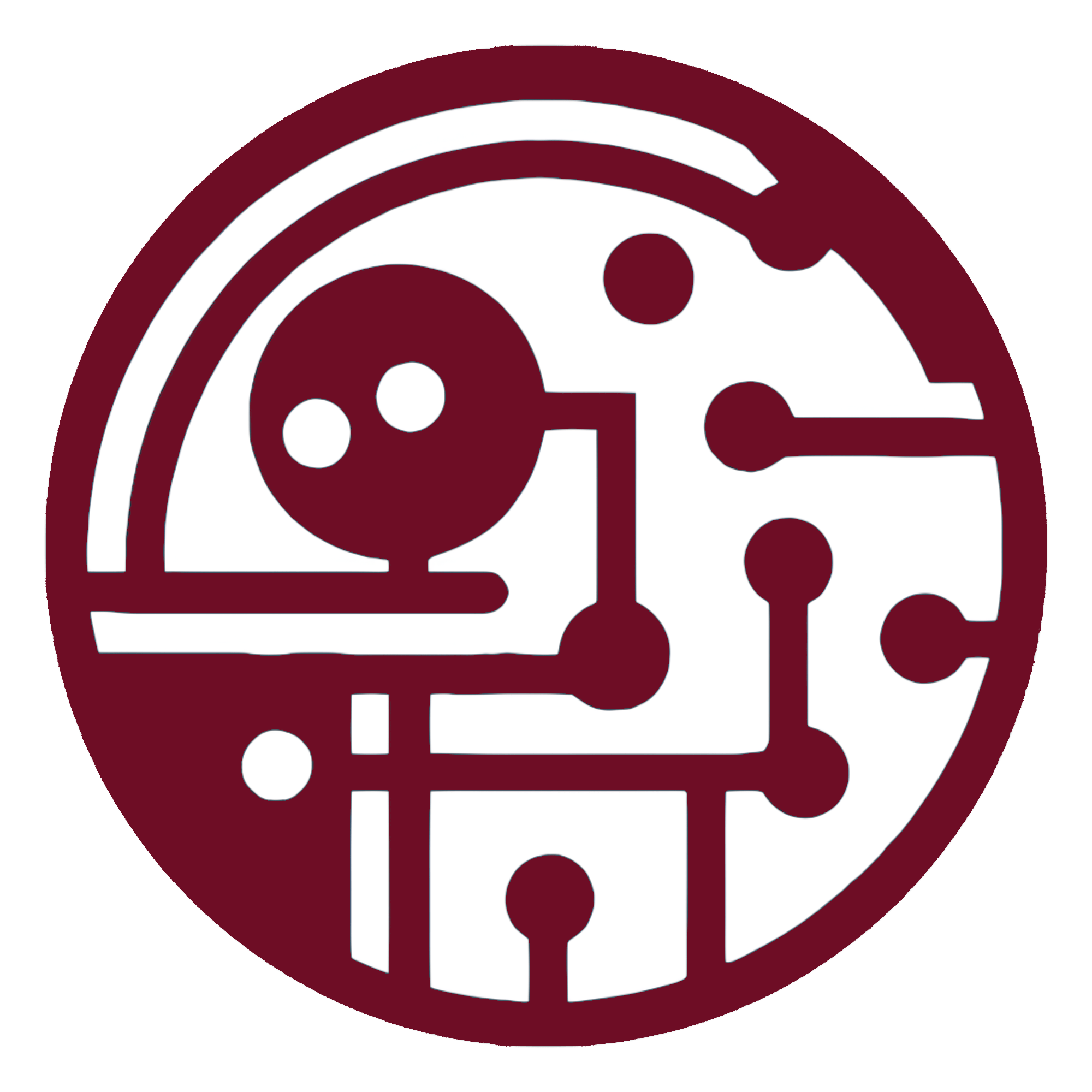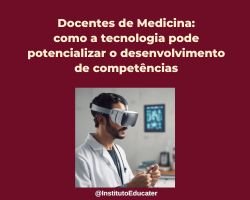Medicine Teachers:
how technology can enhance the development of skills
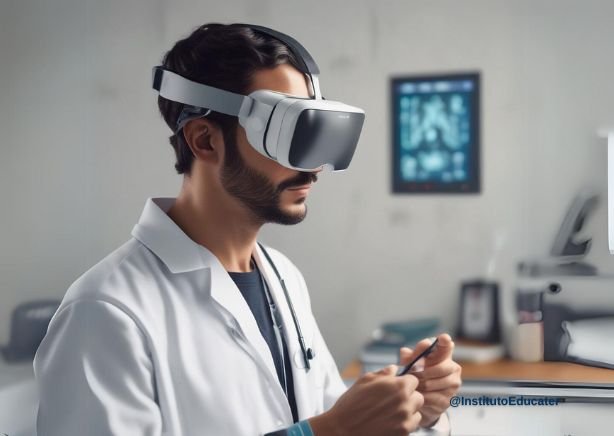
In the digital era, the integration of technology in medical education presents itself as an innovative strategy to enhance the development of teachers' skills. This article explores the multifaceted technological applications that can transform medical education, preparing teachers to face contemporary challenges in the health field.
The integration of technology in the training of medical teachers is not just a trend, it is an emerging need. With the rapid advancement of medical technology and treatment methods, it is essential that educators are as prepared as their students, who will soon be professionals in the field. Technology serves as a bridge between theory and practice, offering teachers tools to better simulate and demonstrate complex procedures.
Virtual Learning Environments (VLE) are a clear example of this transition. They allow not only the distribution of teaching material, but also real-time interaction between students and teachers. This interactivity is critical to adapting teaching to the specific needs of each student, allowing for a more personalized and effective approach to medical education.
Furthermore, medical simulation platforms have evolved from simple teaching tools to complex systems that offer students the chance to practice surgical and diagnostic skills in a safe environment. Such platforms not only improve students' practical skills, but also strengthen teachers' theoretical knowledge by testing and adapting their teaching methodologies in the face of technological innovations.
Another significant innovation is the use of Big Data and predictive analysis. By integrating these technologies, teachers can gain valuable insights into students' progress and difficulties, allowing for more focused and informed educational intervention. This type of data can completely transform the educational environment, making it a more adaptive and responsive learning system.
Furthermore, artificial intelligence has a growing role in medical education. AI tools can take over repetitive and administrative tasks, freeing faculty to focus more on student interaction and mentoring. Furthermore, AI can offer personalized, real-time feedback, an invaluable advantage in the teaching and learning process.
Telemedicine, which has gained prominence especially during recent public health crises, offers an excellent opportunity for teaching. Through it, students can observe and participate in real consultations, an experience previously limited by geography or the availability of clinical cases in the immediate teaching environment.
Finally, ongoing professional development, facilitated by online resources, is essential for medical faculty to stay up to date with the latest discoveries and techniques in their field. Online courses and workshops allow constant updating, essential for medical practice and teaching.
Teachers are encouraged to explore these technologies and integrate them into their pedagogical practices. The next section of this article will discuss how institutions can support faculty in incorporating these technologies into their curricula and daily practices, ensuring continued evolution in the field of medical education.
Discover how technology is revolutionizing medical education in this article.
Dive deeper into the innovations that are transforming education, from virtual learning environments to virtual reality and artificial intelligence. Find out how these tools not only enrich pedagogical practice, but also prepare future doctors for the challenges of the 21st century.
Complete the reading now and dive into the future of medical education!

Virtual Learning Environments
Virtual Learning Environments (VLE) allow medical teachers to create and manage dynamic content that is accessible to students from anywhere. These environments, rich in multimedia resources, facilitate a more interactive and engaged learning experience, allowing the teacher to complement the content taught in the classroom.
These Virtual Learning Environments represent a revolution in medical education, offering teachers a robust platform to disseminate knowledge in an effective and interactive way. These environments are not just content repositories, but dynamic spaces that engage students through multimedia and interactive tools.
The use of VLEs in medical education allows for personalized teaching, where courses can be adapted to the individual needs of students. This is essential in a field as vast and complex as medicine, where each student may need a different focus on specific areas of knowledge.
Furthermore, VLEs facilitate access to learning anytime, anywhere, breaking down geographic barriers that previously limited medical education. This accessibility is especially valuable for students from remote regions or those who combine work and study.
The multimedia resources of VLEs, such as videos, simulations and interactive quizzes, make learning more engaging and retaining. Such resources help in visualizing complex concepts and developing practical skills through virtual simulations.
The discussion forums and collaboration tools available in VLEs also promote greater interaction between students and teachers. This interactivity is important for the development of communicative skills and collaborative learning, important aspects in medical training.
Additionally, VLEs allow for continuous assessment of student progress through analytical tools that provide real-time data. This allows teachers to proactively adjust the course and teaching methodology, ensuring that learning objectives are achieved.
Integrating pedagogical practices with VLE technologies not only enriches the curriculum, but also prepares students to use technologies in their future medical practices. It is preparation for the real work environment, where technology is an indispensable tool.
In the next section, we will explore simulations, augmented reality, and virtual reality, technological tools that take medical education and training to new dimensions. Discover how these technologies are shaping the future of medical education, enabling risk-free practices in controlled, highly realistic environments.

Simulations, Augmented Reality and Virtual Reality
Simulations, augmented reality, and virtual reality offer opportunities for risk-free clinical practices. Such technologies allow medical faculty to guide their students through complex procedures, improving their diagnostic and operational skills in a controlled and safe environment.
Simulations, together with augmented reality (AR) and virtual reality (VR), constitute essential tools in the technological arsenal for teaching medicine. These immersive technologies offer students the opportunity to practice complex medical procedures in a safe environment without the risk of harming real patients.
Virtual reality places students in a completely simulated environment where they can interact with elaborate medical scenarios that mimic reality. This complete immersion helps develop both the technical skills and critical decisions needed in medical practice.
On the other hand, augmented reality enriches the real world with additional digital information. In an educational context, this may mean overlaying vital data or anatomical images during hands-on training, offering a deeper understanding of medical procedures and conditions.
Simulations are particularly useful for practicing emergency surgeries and procedures. These not only reinforce learning, but also increase students' confidence when facing similar situations in real life, ensuring a more effective and measured response.
Furthermore, these technologies allow for a detailed assessment of students’ skills. Instructors can review simulation sessions to identify strengths and areas for improvement, providing specific, progress-oriented feedback to the student.
Integrating AR and VR into the medical curriculum also prepares students for future technological innovations in the healthcare field. As these technologies become more prevalent in clinical settings, students will already be familiar with their use, putting them ahead of the technological learning curve.
This pedagogical approach not only improves medical education but also shapes the future of clinical care. The ability to apply knowledge in a controlled environment before contact with real patients is an indisputable advantage in modern medical training.
With the power to simulate almost any clinical scenario, the opportunities for learning and development are virtually limitless. The next section will cover how Big Data and predictive analytics are transforming the personalization and effectiveness of medical education, ensuring that every student receives the guidance they need to maximize their potential.
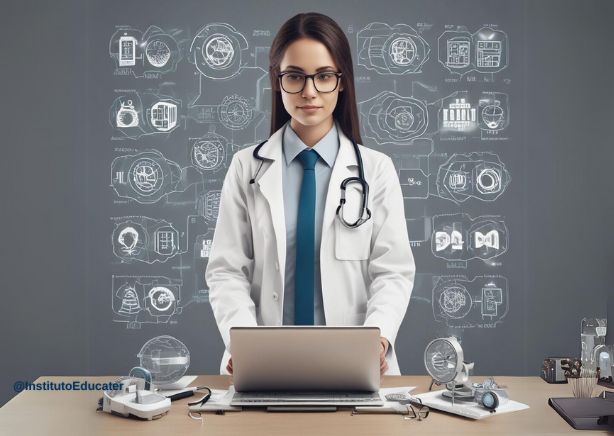
Big Data and Predictive Analysis
The use of Big Data in medical education allows teachers to identify learning patterns, predict student performance and personalize teaching. This predictive analysis can direct attention to areas that need greater support and development.
The use of Big Data and predictive analytics in medical education is revolutionizing the way curricula are developed and how teaching is personalized. These technologies allow teachers to access a large amount of data about students' performance and learning behavior.
With Big Data, it is possible to identify patterns that may not be visible without analyzing large volumes of information. These standards help you better understand student needs, allowing educators to adjust their pedagogical approaches more effectively.
Predictive analysis, in turn, uses algorithms and statistical models to predict future results based on historical data. In an educational context, this means being able to predict which students may struggle with certain topics and proactively offering the necessary support.
This personalization of teaching not only improves individual student performance, but also raises the overall level of medical education. Faculty can focus on areas that require extra attention and ensure that all students reach their full potential.
Furthermore, predictive analysis can help to form more efficient study groups, bringing together students with complementary skills or similar needs, which can strengthen collaborative learning and increase the efficiency of the educational process.
Using these technological tools also prepares students for the real world of medical practice, where using data to make clinical decisions is an indispensable skill. Thus, they not only learn medicine itself, but also how to apply technology to solve complex health problems.
Integrating Big Data and predictive analysis in medical education also helps the educational institution to remain at the forefront of educational innovations, attracting students and professionals interested in a more modern and effective teaching approach.
Exploring these advanced analytical tools is not just an option; it is a necessity to maintain relevance in the competitive field of medical education. Below, we will discover how online collaboration platforms are facilitating global interaction between students and experts, further expanding the boundaries of learning in medicine.
Online Collaboration Platforms
Online collaboration platforms are essential for developing skills in an increasingly interconnected world. They facilitate teamwork, the discussion of clinical cases and the sharing of knowledge between institutions and countries.
Online collaboration platforms have emerged as indispensable tools in the contemporary educational context, especially in medical training. They facilitate interaction between students and teachers from different institutions and countries, promoting a rich exchange of knowledge and perspectives.
These platforms allow not only the sharing of information and teaching resources, but also the discussion of complex clinical cases in real time. This capacity is fundamental for the training of health professionals, as it simulates the collaborative environment they will find in their professional practice.
Through these virtual environments, medical students can work as a team, debating and solving problems together, which reinforces the importance of cooperation and effective communication in the medical field. Furthermore, the experience of intercultural and interinstitutional collaboration prepares students for a globalized job market.
Access to a variety of perspectives and approaches to the same medical issue enriches the learning process by exposing students to multiple methodologies and possible solutions. This exposure is decisive for the development of critical and adaptive thinking, essential skills for any doctor.
In addition to facilitating the discussion of cases, these platforms are also effective for holding online conferences, workshops and seminars, bringing world-renowned experts directly into the virtual classroom. This democratizes access to quality medical education and enriching experiences that were previously limited by geographic barriers.
Also important is the ability of these platforms to store and organize large volumes of educational data, making tracking student progress and reviewing content more efficient and accessible for educators and students alike.
Joining these collaboration platforms not only facilitates collaborative and interactive learning, but also integrates cutting-edge technologies into the educational process, keeping the institution and its students ahead on the global educational stage.
With the continued evolution of technology and the increasing focus on interactive and collaborative education, online collaboration platforms represent a significant advancement in the way medical education is conducted. In the next section, we will examine how artificial intelligence is transforming medical education, offering personalized solutions and instant feedback that enrich the learning process.

Artificial Intelligence in Medical Education
Artificial intelligence (AI) transforms the role of medical teachers by automating administrative tasks and optimizing class planning. Furthermore, AI-based systems can offer instant and personalized feedback to students, accelerating the learning process.
Artificial intelligence (AI) is redefining medical education by automating administrative tasks and streamlining lesson planning, freeing faculty to focus more deeply on instructing and mentoring students. This technology not only simplifies routine operations but also improves the efficiency of the educational process.
AI systems are capable of analyzing student performance in real time, providing instant and personalized feedback. Such feedback is important for developing medical skills as it allows students to correct their mistakes immediately and better understand complex medical concepts.
Furthermore, AI can simulate varied clinical scenarios, challenging students to apply their knowledge in practical and dynamic situations. This not only tests their ability to react in controlled environments, but also prepares them for the uncertainty and complexity of the real cases they will face in their careers.
AI-based systems also contribute to the personalization of teaching. Through machine learning algorithms, AI adapts study materials to individual students' needs, ensuring that each student receives appropriate attention to their areas of difficulty.
This technology also facilitates the creation of collaborative and interactive learning environments, where AI can act as a facilitator of discussions, promoting interaction between students and deepening understanding through structured dialogues and debates.
The use of AI in medical education not only improves the quality of teaching, but also prepares future doctors to work with advanced technologies, a skill that is increasingly necessary in today's global healthcare scenario.
Implementing artificial intelligence in pedagogical practices offers a series of advantages that range from improving the learning experience to optimizing time management and educational resources. This represents a significant leap towards more modern and efficient medical education.
As we continue to explore the impact of technology on medical education, the next section will address how telemedicine is being used as an effective teaching tool, allowing students and faculty to expand their clinical experiences beyond the traditional boundaries of the classroom. Get ready to discover how this tool is revolutionizing the learning and practice of medicine.
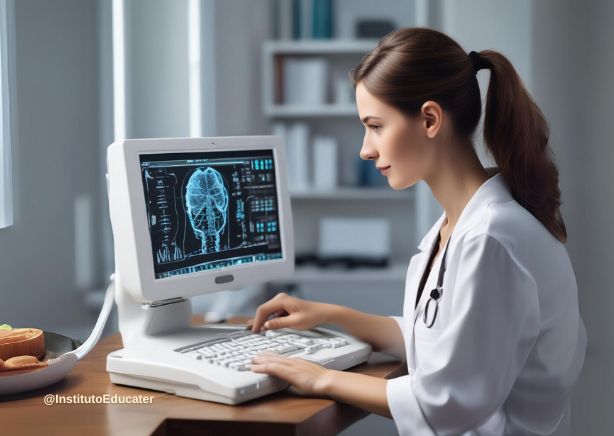
Telemedicine as a Teaching Tool
Telemedicine is not only a clinical tool, but also an effective means of teaching. It allows faculty and students to discuss real cases and develop diagnostic skills remotely, increasing exposure to a variety of medical conditions.
Telemedicine, recognized mainly for its clinical use, has also emerged as a powerful educational tool in medical training. It allows teachers and students to overcome the physical barriers of traditional classrooms, engaging in discussions of real clinical cases in a virtual environment.
This teaching modality offers students the opportunity to observe and participate in the treatment of patients remotely, providing a rich and diverse educational experience. By discussing real cases, students develop diagnostic skills and learn to make clinical decisions under the guidance of their professors.
Telemedicine also facilitates access to a wider range of medical conditions, many of which may not be available locally. This exposes students to a wider range of pathologies and treatments, enriching their training and preparing them for globalized medical practice.
Furthermore, direct interaction with patients, even virtually, helps students develop communication and empathy skills, essential for medical practice. This reinforces the importance of telemedicine not just as a clinical tool, but as an integral component of medical education.
Using telemedicine in teaching also challenges teachers to adapt their pedagogical methodologies, integrating technology, clinical practice and real-time interaction. This encourages pedagogical innovation and keeps the curriculum aligned with technological developments in healthcare.
Practicing clinical skills in a controlled but realistic environment effectively prepares students for today's complex healthcare environment where telemedicine is becoming increasingly prevalent.
Thus, telemedicine not only expands students' diagnostic and clinical capabilities, but also strengthens their knowledge and understanding of contemporary healthcare challenges. It redefines the reach and effectiveness of medical education, better preparing future doctors for an increasingly connected and technologically advanced world.
With the increasing integration of telemedicine into clinical and educational practices, the next section will discuss the importance of online continuing professional development. Medical teachers will find this modality a valuable opportunity to stay up to date with technological advances and new pedagogical approaches, ensuring cutting-edge medical education.
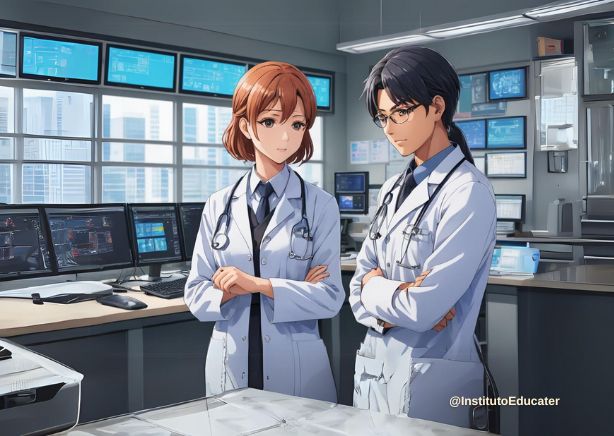
Online Continuing Professional Development
Online continuing professional development courses are essential for medical faculty to stay up to date with the latest advances in their field. These courses offer flexibility, allowing teachers to adapt to new technologies and pedagogical methods autonomously.
Continuing online professional development is a central aspect for medical faculty to remain at the forefront of their field by continually adapting to rapid advances in technology and new teaching methods. These online courses provide an accessible and flexible platform for continuous learning.
Through these courses, teachers have the opportunity to learn at their own pace, choosing times that suit their schedules, which is especially valuable in a profession as demanding as medicine. This flexibility is critical for continued professional development in a rapidly evolving field.
Online courses not only update faculty on the latest clinical and scientific developments, but also expose them to new teaching techniques and educational technologies. This is essential so that educators can integrate these innovations into their own classrooms and teaching practices.
Furthermore, many of these courses are developed and offered by world-renowned institutions, allowing teachers to access superior quality knowledge without the need for physical travel. This democratizes access to high-quality education, regardless of the teacher's geographic location.
Online professional development also fosters a global learning community among medical professionals. Through forums and collaborative projects, teachers can share experiences and challenges with colleagues from around the world, enriching their own educational and clinical practice.
These courses also encourage continuous reflection and self-assessment, essential components for constant improvement in medical education. By reflecting on their practices and learning from leaders in their field, medical faculty can implement effective changes that benefit both themselves and their students.
Investing in online continuous professional development is, therefore, essential for medical teachers to maintain their relevance and pedagogical effectiveness. Continuing training is a fundamental pillar for excellence in medical education and clinical practice.
In conclusion, online continuing professional development is not only a necessity, but an opportunity for medical faculty to enrich their skills and knowledge. The next section will conclude our article, reflecting on how technology will continue to shape the future of medical education, offering teachers increasingly effective tools for their professional growth and improved teaching.
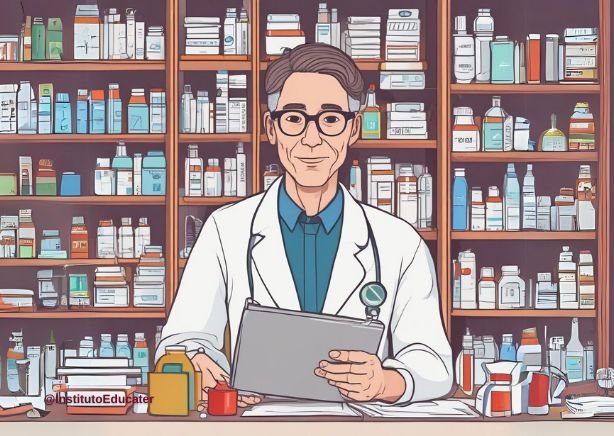
Conclusion
Technology not only broadens educational horizons, but also redefines the way medical skills are developed. Medical faculty are encouraged to explore these technological tools, not only to enrich their teaching practice, but also to better prepare their students for the future of medicine. This article highlights the transformative role of technology, encouraging reflection on its effective implementation in the medical educational environment.
As we move into an increasingly digitized era, it is clear that technology is a key player in reshaping medical education. This article explored several technological tools that have the potential to radically transform medical education, from virtual learning environments to advanced simulations and the use of artificial intelligence.
Virtual Learning Environments allow teachers to create more interactive and engaging learning experiences, adaptable to the individual needs of each student. These environments not only facilitate access to knowledge, but also break down physical and temporal barriers, making learning more flexible and accessible.
Simulations, augmented reality, and virtual reality offer students unparalleled opportunities to practice medical skills in safe environments. These technologies allow students to face complex scenarios without risk, better preparing them for real-world challenges.
Big Data and predictive analytics are powerful tools for personalizing teaching and improving student progress tracking. The ability to anticipate challenges and adapt teaching to individual needs is a huge advantage in training competent and confident healthcare professionals.
Online collaboration platforms expand the boundaries of collaborative learning, allowing students and faculty from different locations around the world to share knowledge and experiences, enriching medical education with a variety of cultural and professional perspectives.
Telemedicine, as shown, is not only a clinical tool, but also an effective means of teaching that allows the discussion of real cases, expanding the reach of medical learning beyond traditional classrooms.
Continuous online professional development ensures that faculty remain up to date with the latest innovations in their field, promoting a continuous cycle of learning and adaptation that benefits both educators and students.
We encourage medical faculty to adopt these technologies not only to enrich their teaching practices, but also to effectively prepare their students for the future of medicine. Technology, as discussed, is not a complement, but a fundamental transformation in the way medicine is taught and learned. We would like to hear your experiences and reflections on implementing these technologies. Send us a message sharing how technological innovation has impacted your educational or clinical practice.
In contemporary times, technology plays a transformative role in medical education, redefining traditional teaching and learning methods. The article "Medicine Teachers: how technology can enhance the development of skills" explores the integration of innovations such as Virtual Learning Environments, advanced simulations, augmented and virtual reality, as well as the application of artificial intelligence and Big Data in the educational context.
These tools not only facilitate a more interactive and engaged learning experience, but also allow faculty to guide students through complex procedures in a controlled and safe environment. Technology also offers the possibility of personalizing teaching, adjusting to students' individual needs and promoting more effective and adaptive learning.
How about sharing this story with your colleagues?
Together, we can inspire positive change in medical education, shaping future healthcare professionals who are more prepared and connected to the needs of the 21st Century.
Share now and be part of this transformation!
Common questions
Technology plays an important role in the development of healthcare, especially in the training and training of medical professionals. The introduction of tools such as digital simulations, augmented reality and artificial intelligence allows medical faculty and students to experience clinical practices in a controlled and safe environment. These technologies not only improve diagnostic and operational skills, but also ensure a deeper understanding of complex procedures essential in modern medicine.
Furthermore, the integration of Big Data platforms and predictive analytics in the healthcare sector allows professionals to identify disease patterns, optimize treatments and personalize patient care. These advances help to raise the level of care and efficiency of medical interventions, having a direct impact on patients' quality of life and the management of healthcare resources.
Telemedicine has also transformed access to healthcare, enabling remote consultations and diagnoses, which is essential for remote regions or for patients with reduced mobility. This technology not only expands the reach of medical services, but also contributes to the continuity of treatment, essential for the management of chronic diseases and for reducing costs in the healthcare system.
For more information on how technology is reshaping the healthcare field, visit the full article here.
Technology can enhance learning by providing resources and tools that make the educational process more dynamic and accessible. Online teaching platforms and Virtual Learning Environments (VLE) allow students to have access to a wide range of teaching materials in different formats, including videos, podcasts and interactive simulations. These resources make it easy to personalize teaching, adapting to the different learning styles and paces of each student.
Furthermore, technology in education fosters collaboration and communication between students and teachers, even in remote environments. Tools such as forums, chats and video conferences allow real-time interactions that are essential for exchanging ideas and developing social and professional skills. This interactivity is essential to keep students engaged and motivated in their studies.
Finally, artificial intelligence and data analysis offer the possibility of continuous monitoring of student progress, allowing educators to further personalize teaching and intervene promptly when necessary. Intelligent systems can, for example, recommend additional resources based on each student's specific difficulties, optimizing learning and maximizing academic performance.
Technology plays a fundamental role in scientific development by providing tools and platforms that facilitate large-scale experimentation, data analysis and collaboration. For example, the use of supercomputers and advanced software allows scientists to process large volumes of data quickly, which is essential for research in areas such as genomics and quantum physics.
Additionally, modern communication technologies, such as video conferencing and online collaboration platforms, allow researchers from different parts of the world to work together effectively. This global interconnection accelerates the exchange of ideas and the advancement of scientific projects, expanding the frontiers of human knowledge.
Finally, artificial intelligence and automation are transforming scientific methods, allowing experiments to be carried out with greater precision and in less time. AI can identify patterns and connections that would be difficult to detect manually, opening new avenues for scientific discovery and technological innovation.
Technology can significantly transform teaching and learning by integrating digital tools that personalize and enrich the educational experience. Online learning platforms, for example, offer interactive features such as videos, interactive quizzes, and simulations that can make learning more engaging and adaptable to students' individual needs.
Furthermore, technology facilitates access to quality education for students in remote regions or with limited resources. With distance learning, students from all over the world can access high-level educational content and interact with teachers and classmates virtually, breaking geographical and social barriers.
Using data analytics and artificial intelligence tools also allows educators to monitor student progress in real time, adapt teaching methods, and offer personalized support. This optimizes the learning process, ensuring that educational interventions are more targeted and effective.
Technology has the potential to revolutionize medical education by integrating advanced tools that improve both teaching and clinical practice. Virtual Reality (VR) and Augmented Reality (AR) platforms allow medical students to perform procedures in a safe and controlled environment, which accelerates the learning curve and reduces the risk of errors in real-life situations.
Additionally, artificial intelligence (AI) can transform medical education by automating administrative tasks and providing personalized feedback to students. AI systems can analyze student performance in real time, identifying areas that need attention and helping to personalize the learning process for each student.
Lastly, telemedicine technologies are becoming increasingly relevant, especially in rural or underserved areas, allowing students and doctors to access appointments and procedures remotely. This practice not only expands access to quality medical education, but also prepares students for medical practice in a variety of contexts, increasing their versatility and ability to adapt.
The use of technology in medical education offers several positive points that enrich the teaching-learning process. One of the main benefits is the ability to provide realistic simulations that allow students to practice skills and procedures without risk to patients. These simulations help build confidence and competence before direct contact with real cases.
Another positive point is the expanded access to diverse and high-quality educational resources. Online platforms allow students to access lectures, workshops and teaching materials from anywhere in the world, ensuring more comprehensive and up-to-date training.
Furthermore, technology makes it easier to personalize learning. Data analysis tools and adaptive systems allow you to adjust the content and pace of teaching to the individual needs of each student, maximizing learning potential and improving educational results.
The use of technology in medical education brings significant benefits, starting with improving accessibility to knowledge. Online learning platforms and digital resources allow students around the world to access high-quality educational content, regardless of their geographic location.
Furthermore, technology offers tools such as simulations and virtual reality, which provide risk-free practical experiences. These methods allow medical students to develop critical skills in a controlled environment, better preparing them for real-world situations in medical practice.
Another benefit is the ability to personalize teaching. Systems based on artificial intelligence can analyze student performance in real time, adapting the curriculum to individual learning needs, which enhances each student's training process.
Technology plays a central role in the teaching and learning process by providing tools that make education more accessible, interactive and personalized. By integrating digital resources such as e-learning platforms and multimedia content, educators can deliver richer, more engaging learning experiences that cater to a wider range of learning styles.
Additionally, technology facilitates collaboration and communication between students and teachers, regardless of their physical location. This is particularly important in an increasingly globalized world, where the ability to connect and learn in virtual environments is critical.
Finally, technology allows for the implementation of adaptive systems and data analytics to monitor student progress and adjust teaching methods to their specific needs. This not only improves the effectiveness of teaching, but also ensures that all students have the opportunity to reach their full potential.
The use of technology in medical education offers multiple benefits, starting with the ability to provide more interactive and engaging learning experiences through simulations and virtual reality. These tools allow medical students to practice procedures in a safe and controlled environment, which is essential for developing clinical skills without putting patients at risk.
Additionally, technology facilitates access to up-to-date information and high-quality educational resources, allowing students and professionals to stay up to date with the latest advances in their field. This is important in a rapidly evolving field like medicine.
Lastly, technologically advanced medical education promotes greater flexibility and personalization of teaching. Online platforms and analytical tools allow educators to monitor student progress in real time and adjust curriculum to each student's specific needs, optimizing learning and improving educational outcomes.
The use of technology is significantly transforming the role of both the teacher and the student in the educational context. For teachers, technology offers tools that automate administrative tasks and allow a greater focus on facilitating learning and providing individualized support for students. This changes the traditional role of the teacher from a transmitter of knowledge to a mentor and facilitator of the learning process.
For students, technology provides more active participation in their own education. They have access to a variety of online educational resources and interactive tools that allow them to explore and learn independently, promoting a more student-centered approach and more personalized learning.
Additionally, technology empowers students to collaborate more effectively with their peers, both locally and globally. Online collaboration platforms and communication tools help create a learning community where students can share knowledge, discuss ideas, and work on joint projects, transcending the physical barriers of the traditional classroom environment.
Technology can be applied in the classroom in many ways, enriching both teaching and students’ learning experience. A common application is the use of digital devices such as tablets and computers, which allow access to interactive teaching materials, multimedia resources and educational applications. These resources transform the way content is presented, making classes more dynamic and participatory.
Another significant application is the use of online learning platforms, which facilitate the implementation of methodologies such as blended learning. These platforms allow students to access lessons and exercises outside of the school environment, optimizing time in class for deeper discussions and practical activities.
Furthermore, technology enables the incorporation of virtual and augmented reality tools, which can simulate complex environments or processes, providing students with immersive and educational experiences that would be impossible in a traditional context. These features are especially valuable in disciplines that require detailed visualization of phenomena or structures, such as science, geography, and medicine.
Technological transformations have the potential to revolutionize teaching practice by introducing tools that increase teaching effectiveness and provide new pedagogical methodologies. With the advent of online learning platforms, for example, teachers can offer personalized content that adapts to each student's pace and learning style, allowing for more accurate monitoring of individual development.
Additionally, technologies such as virtual and augmented reality allow teachers to create immersive and interactive learning experiences, which can simulate real-life situations or visualize abstract concepts, making learning more concrete and understandable.
The use of analytical and artificial intelligence tools also transforms teaching practice by enabling the analysis of large volumes of data on student performance. This helps teachers identify patterns, predict learning difficulties and adjust teaching strategies in real time, ensuring that educational interventions are more effective and evidence-based.
Teachers can use technology to innovate their teaching practice in several effective ways. The adoption of digital educational tools, such as interactive learning platforms and educational apps, allows for the creation of personalized content that meets each student's individual needs, facilitating deeper and more efficient learning.
Additionally, using methodologies such as flipped classrooms, where students access learning content at home through videos or other digital tools and use class time for discussions and hands-on activities, can significantly increase engagement and retention. of knowledge.
Teachers can also integrate technologies such as augmented and virtual reality to simulate real or complex situations, which not only makes learning more interesting but also more applicable to real life. These practical experiences are important for preparing students for the challenges of the professional and academic world.
The role of the teacher in the use of technology is decisive and multifaceted, ranging from selecting and integrating appropriate technological tools into the curriculum to facilitating a learning environment that effectively leverages these technologies. Teachers act as mediators between technology and students, ensuring that digital resources are used to enhance teaching and learning.
In addition to integrating technology, teachers must stay up to date with technological and pedagogical innovations to ensure that the tools they use are the most effective for their educational goals. They also have a responsibility to empower students to use technology ethically and responsibly.
Finally, teachers need to constantly evaluate the effectiveness of adopted technologies, adjusting and personalizing teaching approaches to meet students' learning needs. This adaptive and reflective role is essential to maximizing the positive impact of technology in education.
Technology has profound and varied impacts on pedagogical practice, transforming the educational environment and the way teaching is conducted. One of the main impacts is the personalization of learning, where technological tools allow educators to adapt teaching to the individual needs of each student, improving effectiveness and engagement.
Another significant impact is increased access to rich and diverse educational resources. Technology allows students and teachers to access vast amounts of information and teaching materials online, breaking down geographical barriers and providing more inclusive and comprehensive learning.
Additionally, technology facilitates the implementation of active learning methodologies, such as collaborative projects and problem-based learning, that encourage students to become active participants in their learning process. These approaches promote critical skills such as critical thinking, collaboration, and self-learning.
Your message is important to us
Important
This is an open invitation to educators, students and healthcare professionals to engage in this educational transformation. Your participation, whether sharing experiences, ideas or challenges, is crucial to shaping the future of medical education. We are at an inflection point: together, we can lead the change toward medical education that truly meets society's needs. Are you ready to be part of this evolution?
